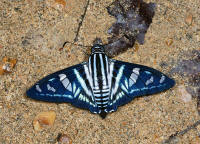 | Pyrrhopyginae – Swifts, Sabre-wings Jemadia menechmus ( Peru ) A subfamily confined to South America and the part of Central America south of the Rio Grande, Mexico. There are 168 known species. Genera include Myscelus, Passova, Zonia, Pyrrhopyge, Jemadia & Mysarbia. The butterflies are very stout-bodied, and average 40-60mm in wingspan. They fly powerfully around the forest canopy, but descend to feed at mud or bird-droppings. |
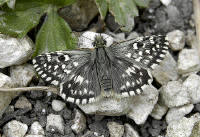 | Pyrginae – Flats, Spreadwings Pyrgus malvae ( England ) Pyrginae are represented in all temperate and tropical areas of the world. They commonly bask on the ground or on foliage with their wings held flat. Many tropical species habitually rest under leaves with wings outspread. Species from temperate regions often roost overnight on dead flower-heads. The males of many genera have a small fold on the leading edge of the forewings, containing androconial scales. |
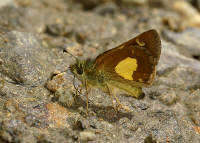 | Heteropterinae – Chequered Skippers Dalla cypselus ( Peru ) The Heteropterinae are a fairly small sub-family comprised of about 140 neotropical species, and 30 or so in the Holarctic region. They are all small butterflies, averaging between 30-40mm in wingspan. Most have dark brown uppersides, dappled with cream or orange spots. The larvae of all species feed on grasses. |
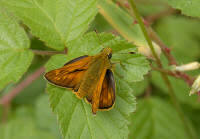 | Hesperiinae – Grass Skippers, Trapdoor Skippers Ochlodes sylvanus ( England ) All Hesperiine larvae feed on monocotyledons. Adults of most species have fuscous or chocolate wings, often marked with pale spots or hyaline windows. When resting they hold their wings erect, or adopt the posture illustrated here. Temperate species commonly nectar at flowers, but those from tropical areas feed at mud, rotting vegetation or bird droppings. The former subfamily Megathyminae is now included in the Hesperiinae. |
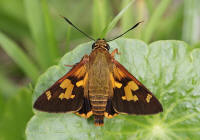 | Trapezitinae – Australian Skippers Trapezites symmomus ( Australia ) A group of about 60-70 smallish, heavy-bodied skippers, all of which are confined to the Australian/Papuan region. Unlike the Hesperiinae, males of Trapezitinae do not possess androconial sex brands. There are 18 genera. Trapezites is the largest, with between 15-18 species depending on taxonomic interpretation. Each genus of the Trapezitinae specializes on particular larval foodplants, e.g. Trapezites all feed on spike rush Lomandra. |
 | Coeliadinae – Policemen, Awls The Policemen and Awls are a group of large robust skippers with a fast whirring flight similar to that of hawkmoths. They are active from dawn to early evening, and frequently visit flowers for nectar. There about 75 species worldwide – 18 in Africa, 12 in Australasia, and about 45 in the Oriental region. |
 | Euschemoniinae – Regent Skipper Euschemon rafflesia ( Australia ) This subfamily contains just one species -the Regent Skipper Euschemon rafflesia, an Australian insect in which the fore and hindwings are coupled together in flight by a frenulum- a feature found in all moths, and in the ‘butterfly-moths’ Hedylidae, but not in the 5 traditional butterfly families. |
| Papilionidae – Here I follow the classification adopted by Tyler, Doubleday and Lamas. There are about 590 known species of Papilionidae worldwide. The majority are large colourful butterflies. Many have short tail-like extensions on their hindwings, and hence are popularly known as swallowtails. The caterpillars can be either cryptically coloured or aposematic, depending on subfamily and tribe. All Papilionid caterpillars possess an extrusible organ called an osmaterium, which exudes foul smelling scents to deter predators and parasitoids. The pupae of all species are cryptically coloured, and are usually formed head-upwards, attached by the cremaster and a silk girdle to a leaf or stem. |
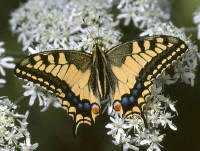 | Papilioninae – Swallowtails, Birdwings, Dragontails Papilio machaon gorganus ( France ) About 540 medium or large species, found throughout the tropical, temperate and sub-arctic regions of the world. The exquisite Dragontails of the Oriental region zip back and forth very rapidly, and resemble dragonflies in flight. Most others including the Swallowtails and the spectacular Birdwings of New Guinea, have a fast fluttering flight, and keep their wings constantly in motion when nectaring. |
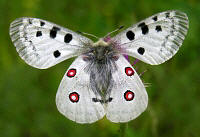 | Parnassiinae – Apollos Parnassius apollo ( France ) About 50 species found in alpine and sub-arctic regions of the northern hemisphere – 3 in North America, 3 in Europe, and the remainder in mountainous regions of temperate Asia. All species are poisonous to vertebrates. Most have semi-transparent whitish wings, marked with prominent red or orange ocelli. |
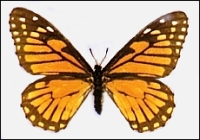 | Baroniinae Baronia brevicornis ( Mexico ) A sub-family erected to accommodate a single species, Baronia brevicornis, a locally common endemic of the mountains of western Mexico. It is a smallish butterfly, marked with pale yellow patches on a brown ground colour, and is characterised by having extremely short antennae. |
| Pieridae Here I retain the classification proposed by Klots. The Pieridae comprises 1036 described species worldwide and includes the whites, yellows, orange tips, ithomiine-mimics and jezebels. Their eggs are spindle-shaped and vertically ribbed. The larvae of most genera are cryptically coloured, naked or slightly hairy, and without appendages. The pupae are also cryptically coloured, and attached head-upwards by the cremaster and a silken girdle to the substrate. |
 | Coliadinae – Sulphurs, Yellows, Brimstones Gonepteryx rhamni ( England ) The Coliadinae are found on all continents. Most species are strongly migratory, including the Grass Yellows and Sulphurs, which migrate seasonally along the routes of rivers, and settle in vast numbers on the sandbanks of Amazonian tributaries. Other species such as the Brimstones, are nomadic by nature, and very adaptable to different environments. |
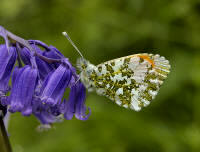 | Pierinae – Whites, Orange-tips, Jezebels, Pereutes Anthocharis cardamines ( England ) The Pierinae are very cosmopolitan of all butterflies, having representatives occurring on all continents and in all habitats including tropical rainforests, temperate woodlands, alpine pastures, deserts, moorland and tundra. Most have a white ground, often marked with black, yellow or orange. They include the Orange tips, Whites, Arabs, Vagrants, Dotted Borders, Flip-Flops and Jezebels. |
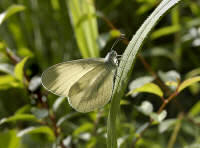 | Dismorphiinae – Wood Whites, Mimics Leptidea sinapis ( England ) The name Dismorphiinae refers to the fact that many members of this predominantly tropical group are sexually dimorphic – i.e. the males and females differ markedly in appearance. Many are also mimetic, e.g. Patia orise from Brazil is an almost perfect mimic of the Ithomiine Glasswing Methona confusa. |
| Lycaenidae There are about 4500 described species of Lycaenidae worldwide, although the number of known species is increasing rapidly as a result of work by Robbins and others in the neotropics. The adult butterflies are generally small and brightly coloured, often with metallic blue or coppery uppersides. The larvae are typically slug-shaped, cryptically coloured, and often resemble leaf blisters or buds. In most cases they live in association with ants, which milk their honey glands to obtain a sugary secretion. The ants coincidentally act as guards, protecting them from predatory insects. In many species the relationship is complex, and can involve the larvae living within ant nests, and feeding carnivorously on ant grubs. Other species feed on aphids or fungi cultivated by ants. The pupae do not possess a cremaster. In some species they are formed loosely on the surface of the ground. In others they are attached by a silk girdle to a leaf or stem. This treatment follows Robbins’ revision of the Theclinae. The remaining sub-families follow the classification used by Lamas et al. |
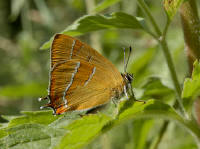 | Theclinae – Hairstreaks, Sunstreaks, Oakblues etc. Thecla betulae ( England ) The Theclinae comprises about 2000 species worldwide, over 1100 of which occur in the neotropics. They are commonly known as hairstreaks, a name derived from the white hair-line streaks found on the undersides of most species. Another common characteristic is the presence on most species of tails on each hindwing. The butterflies are noted for their fast and very erratic flight around bushes and trees. |
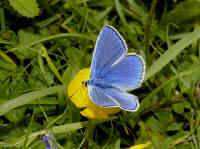 | Polyommatinae – Blues, Arguses, Caeruleans Polyommatus icarus ( England ) Polyommatinae means “many-spotted”, and refers to the pattern of small dark spots or blotches on the undersides of most species. Males generally have blue uppersides, while females tend to be brownish, often with orange or red sub-marginal lunules. The butterflies primarily breed in grassland or sub-alpine habitats, and visit flowers for nectar. |
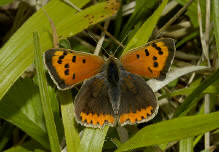 | Lycaeninae – Coppers, Sapphires, Silverlines Lycaena phlaeas ( England ) The Lycaeninae are found mainly in grassland, moorland and marshland areas of the Holarctic region, although a few species occur in the tropics and in New Zealand. Most species have fiery copper uppersides, often with dark borders and a pattern of dark spots. Males typically set up territories, voraciously defending them against any intruding insect. |
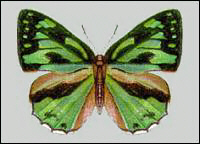 | Poritiinae – Gems Poritia phormedon ( Borneo ) The Poritiinae are exclusively Asian, with about 30 species found from Assam to Malaysia, the Philippines and Sulawesi. All are very rare, and found in rainforests and cloud-forests up to an elevation of about 2000m. All Poritiinae species are sexually dimorphic. Males are marked with iridescent blue or green, while females are marked with small patches of white, orange or red, depending on species. |
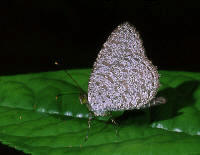 | Miletinae – Brownies, Darkies Allotinus horsfieldi ( West Malaysia ) A fascinating group of small delicate butterflies, mottled or stippled with brown on a whitish ground colour. There are about 80 species in south-east Asia, 45 in Africa, and one in North America. The larvae of all species are carnivorous, feeding on aphids and other Homoptera, although one Sumatran species lives in ant nests and feeds on the grubs. |
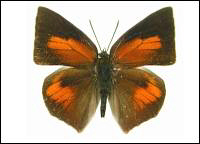 | Curetinae – Sunbeams Curetis santana ( Singapore ) This sub-family comprises of a single genus, Curetis, with 15 known species, found in rainforest, tropical dry forest and coastal habitats in the Oriental region. Males have fiery iridescent copper uppersides, but the females are brown, with large yellowish or white patches, and can be mistaken for small Pierids when in flight. |
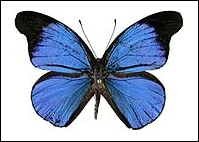 | Lipteninae – African Liptenids Epitola posthumus ( Ghana ) An exclusively African subfamily of 522 species, found mainly in the rainforests of Ghana, Cameroon, Gabon and the Congo. The larvae feed on lichens. The butterflies are small and often brilliantly coloured. They are sometimes seen flying around the trunks of fig trees, or settled on dry twigs. If disturbed by ants, they remain on the twigs, slowly fanning their wings. |
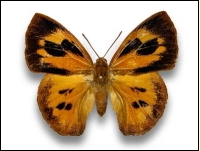 | Liphyrinae – Moth butterflies Liphyra brassolis ( Sumatra ) A small sub-family comprising of 22 small stout-bodied African species, and 3 Liphyra species including the “moth butterfly” Liphyra brassolis. Its larvae live during the latter part of their lives in nests of the weaver ant Oecophylla smaragdina. They are smooth, elliptical and flattened, with a hard shell which protects them from being attacked by the ants. The adult butterflies lack a proboscis and cannot feed. |
| Riodinidae This family was in the past known as the Eryciinidae or Nemeobiidae and is regarded by some as being a sub-family of the Lycaenidae. In this treatment I follow Stichel, Harvey, Hall, d’Abrera, Lamas, Willmott and Callaghan, who regard it as a family in it’s own right. There are about 1500 species of Riodinidae, the vast majority of which are confined to the neotropical region. They are generally small in size, but very diverse in shape, colour and pattern. Many have metallic green, blue or orange areas on the uppersides, hence they are popularly known as metalmarks. Some species have long tails on the hindwings and resemble miniature swallowtails. Metalmark larvae are similar to those of the Lycaenidae, but do not normally associate with ants. In many neotropical species the larvae are adorned with prominent tubercules or other protuberances. As with the Lycaenidae, the pupae do not possess a cremaster, and according to species are either formed loosely on the surface of the ground, or are attached by a silk girdle to a leaf or stem. |
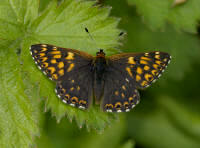 | Riodininae – Metalmarks, Underleafs, Doctors etc. Hamearis lucina ( England ) The Duke of Burgundy illustrated here is the only European member of the Riodinidae. In South and Central America there are 1150 known species in the sub-family Riodininae. Most are roughly similar in size to the Duke of Burgundy, but many are marked with metallic green, blue, purple, copper and red scales, and are commonly known as metalmarks. |
 | Euselasiinae – Euselasias Euselasia gelanor ( Peru ) This sub-family is confined entirely to the neotropical region. There are 172 known species. The butterflies range between about 25 – 40mm in wingspan. They habitually hide under leaves, with their wings held erect, occasionally darting out to investigate other butterflies. The undersides are generally marked with vertical bands in shades of brown, white and orange, but the uppersides are typically black or chocolate, with large patches of bright red or iridescent blue. |
| Nymphalidae Many of the sub-families described below were previously considered to be families in their own right. In this treatment I follow Wahlberg’s 2008 classification in which the 6000 Nymphalid species are divided into 12 subfamilies. These each have their own distinctive characteristics but are united by one common feature – the forelegs of the adults are greatly reduced in size and are useless for walking. In males they are reduced to such a degree that they are little more than hairy stumps, hence the popular term ‘brush-footed’ butterflies. |
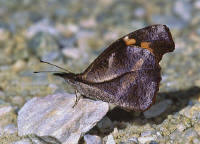 | Libytheinae – Beaks Libythea myrrha ( West Malaysia ) A very small sub-family with only 19 species worldwide, but represented on all continents and on many islands. Some taxonomists still consider Libytheidae to be a full family. The butterflies are characterised by having very long beak-like labial palpi. When at rest the jagged brown wings take on the appearance of dead leaves, with the “beak” resembling a leaf stalk. |
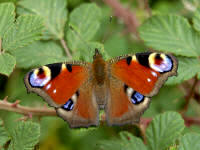 | Nymphalinae – Aristocrats, Checkerspots etc Inachis io ( England ) The Nymphalinae includes many of the world’s most familiar species, including the Peacock, Red Admiral & Painted Lady. Other representatives include the genera Junonia, Siproeta, Anartia, Kallima, Hypolimnas and the smaller Fritillaries in the genera Euphydryas, Chlosyne, Melitaea and Mellicta, all of which were formerly included in the now defunct sub-family Melitaeinae. |
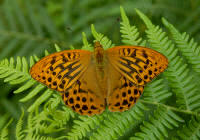 | Heliconiinae – Longwings, Fritillaries etc Argynnis paphia ( England ) A contentious combination of taxa including about 70 species of Heliconiini – neotropical rainforest species marked with patches of cream, red and blue; and the Argynnini which comprises of about 70 black-spotted temperate woodland butterflies, typified by the Silver-washed Fritillary illustrated here. |
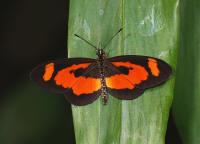 | Acraeinae – Acraeas, Altinotes etc Acraea bonasia ( Ghana ) Some workers regard the African Acraea and South American Altinote / Actinote / Abananote genera as being members of the tribe Acraeini, which they place in the subfamily Heliconiinae. Recent DNA research however indicates that they are distinct from the Heliconiinae, thus I treat them here as members of the subfamily Acraeinae. |
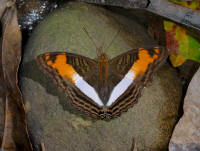 | Limenitidinae – Gliders, Sailors, Sisters, Foresters Adelpha capucinus ( Peru ) In 2003 Wahlberg reclassified the Limenitidinae, excluding many genera which are now reassigned to the Biblidinae. The revised arrangement is more rational, including only a few very obviously related genera e.g. Adelpha, Limenitis, Neptis, Athyma and Moduza. All are forest dwelling species noted for their graceful flight and distinctive uppersides, banded with white and / or orange. |
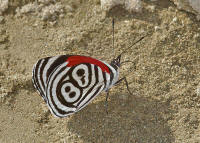 | Biblidinae – Crackers, Numberwings Diaethria clymena ( Peru ) The Biblidinae are a large group of very colourful forest butterflies which to the layman have few obvious features in common. The vast majority of genera such as Diaethria, Nessaea, Hamadryas & Panacea are restricted to the neotropics although a few genera including Ariadne & Neptidopsis are found in Africa. |
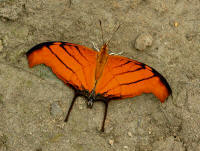 | Cyrestinae – Daggerwings, Mapwings, Maplets Marpesia petreus ( Peru ) The subfamily Cyrestinae include the spectacular Marpesia Daggerwings of the neotropics, which roost overnight in clusters of up to 50, hanging beneath leaves. Also included are the oriental Cyrestis Mapwings & Chersonesia Maplets, which commonly rest under leaves, with their wings fully outspread. |
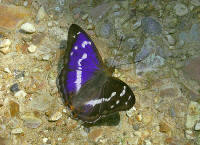 | Apaturinae – Emperors, Princes, Doxocopas Apatura iris ( England ) There are about 50 species of Apaturinae worldwide, all forest dwelling butterflies noted for their with powerful flight. Males obtain their sustenance from minerals dissolved in mud, sap, rotting fruit, carrion or dung, and transfer the proteins to females during copulation. Neither sex visit flowers. Males of Apatura and Doxocopa display a brilliant purple, blue or green sheen when viewed at certain angles. |
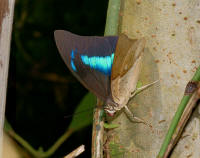 | Charaxinae – Leafwings, Pashas, Preponas, Agrias Archaeoprepona amphimachus ( Peru ) Only one member of the Charaxinae is found in Europe, Charaxes jasius. The majority of species are restricted to tropical / sub-tropical areas, with the greatest concentrations in Africa and South America. They are powerful flyers, found primarily in rainforest and tropical dry forest habitats. Many have convincing “dead-leaf” undersides, but some such as Agrias have intricate patterns in red, cream and blue. The uppersides usually have bright blue or red bands or patches. |
 | Satyrinae – Browns, Phantoms, Palmflies Melanargia galathea ( England ) Satyrine larvae feed on grasses, palms or bamboos. In the Holarctic region the subfamily is represented by the Browns, Heaths, Ringlets, Marbled Whites & Graylings. Their African and tropical Asian counterparts include ringlet-like genera such as Ypthima & Mycalesis. South America has by far the greatest diversity, with the transparent Cithaerias, skulking Pierella, and Euptychia ringlets being well known examples. |
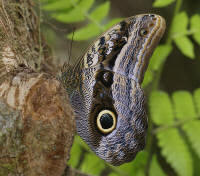 | Morphinae – Morphos, Owls, Jungle Glories Caligo oileus ( Peru ) The Morphinae includes some of the largest & most dazzling butterflies on Earth – the enormous iridescent blue Morpho butterflies which flap slowly along river courses in Central & South America. Other members of the subfamily include the Jungle Glories of Asia ( Amathusiini ), and the neotropical Caligo Owl butterflies ( Brassolini ). The huge “owl” eyespots of the the latter serve a dual role – acting as a threat when intimidated, and as decoys in the event of attack. Recent molecular study strongly suggests that the Morphinae are a tribe of Satyrinae. |
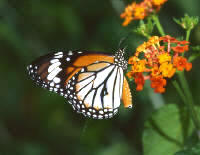 | Danainae ( Danaini ) – Monarchs, Tigers, Crows Danaus genutia ( West Malaysia ) There are about 200 species of Danaini. Only 2 species have been recorded in Europe – Danaus plexippus and D. chrysippus. The larvae of all species assimilate toxins from their foodplants, and pass them on to the adult butterflies, rendering them unpalatable to birds. This unpalatability is advertised by the bright orange and black patterning on the wings, which in turn is mimicked by various other toxic and non-toxic species from other sub-families. |
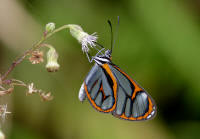 | Danainae ( Ithomiini ) – Glasswings, Tiger-mimics Ithomia terra ( Peru ) Ithomiines fall ( unscientifically ) into 2 groups – the orange and black banded Tiger-mimics, and the transparent Glasswings. They occur exclusively in neotropical rainforests and cloudforests. The adult males feed at Heliotropium and Eupatorium to obtain pyrrolizidine alkaloids, which they chemically convert into pheromones. They gather at “leks” to release their pheromones to attract mates. |
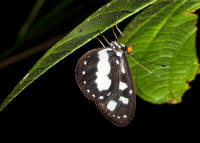 | Danainae ( Tellervini ) – Hamadryads Tellervo assarica ( New Guinea ) The Tellervini was originally thought to comprise of a single Australasian species Tellervo zoilus, with 9 subspecies. Recent research however has led to all of these being elevated to full species status. The butterflies are allied to the Danaini and Ithomiini, but differ morphologically from both in several respects. They are found in Queensland, Papua and the Solomon Islands. |
| Hedylidae The 35 species of the family Hedylidae are nocturnal and moth-like in appearance. The early stages however have many butterfly-like characteristics. The eggs for example are structurally closer to those of Pieridae and Nymphalidae than to moth eggs. The caterpillars have horn-like processes like Apaturinae, a bifid tail as found in Satyrinae, and secondary setae as found in Pieridae. They also have an “anal comb” used for expelling droppings – a characteristic of the Hesperiinae. The pupae likewise have structural characteristics more representative of butterfly pupae, and are secured to the substrate with a silken girdle, just like those of the Pieridae and Papilionidae. |
| Hedylidae – Butterfly-moths Macrosoma heliconaria ( Peru ) The Hedylidae have not yet been assigned any subfamilies or tribes. All Hedylidae are placed in the same genus – Macrosoma. There are 35 species distributed variously from Mexico to Bolivia. The greatest concentration is in southern Peru where at least 26 species occur. |




































